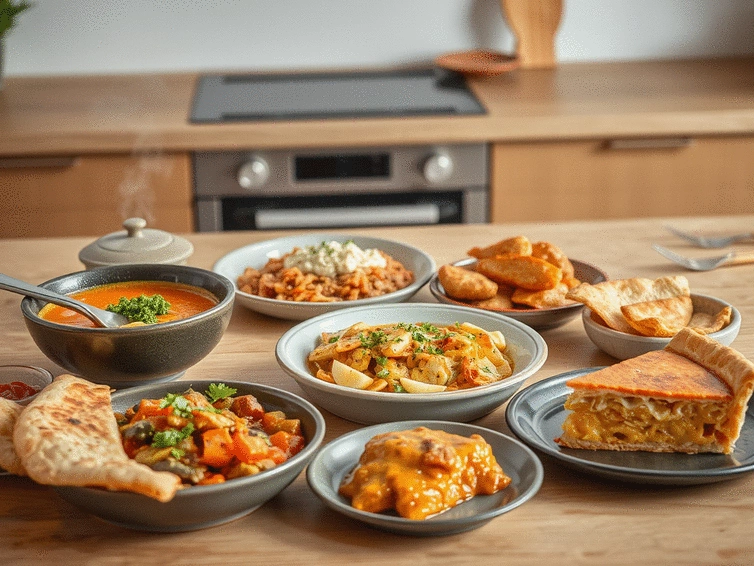
Global Comfort Foods Explored
What if your favorite meal could tell a story? Comfort foods are more than just dishes; they are the narratives of our lives, reflecting our traditions, emotions, and cultural identities. Join us in uncovering the delightful world of comfort foods and their profound connections to our hearts and homes.
What You Will Learn
- Familiarity and Nostalgia: Comfort foods often evoke memories tied to family and home, creating a sense of warmth.
- Emotional Connections: Enjoying comfort foods can release dopamine, helping to alleviate stress and foster connections with loved ones.
- Culinary Traditions: These dishes reflect cultural significance and historical roots, preserving stories and practices passed down through generations.
- Adaptation and Diversity: Comfort foods vary across cultures, showcasing unique ingredients and cooking methods that enhance our understanding of each other.
The Diverse Tapestry of Global Comfort Foods
Comfort foods are more than just meals; they are a celebration of cultural identity and community. The visual below highlights key characteristics and their profound impact.
What Defines Comfort Food?
- •Familiar flavors & nostalgia
- •Simple ingredients
- •Emotional connection
Impact of Comfort Foods
- •Reduces stress & anxiety
- •Fosters social connection
- •Triggers memory recall
Culinary Traditions & Influence
- •Seasonal ingredients used
- •Historical & cultural roots
- •Traditional preparation methods
Role in Cultural Identity
- •Symbolism & celebrations
- •Fosters community bonds
- •Preserves family traditions
- •Adaptation by communities
Understanding Global Comfort Foods: A Cultural Exploration
As we dive into the world of comfort food, it’s essential to first unpack what makes these dishes so beloved across different cultures. Comfort food isn’t merely about taste; it reflects our traditions, memories, and emotions. Each culture has its unique definition of comfort food, shaped by history, geography, and personal experiences. So, what really defines comfort food across cultures? Let’s explore!
What Defines Comfort Food Across Cultures?
At its core, comfort food is about familiarity and nostalgia. For some, it might be a warm bowl of ramen, while for others, it could be a slice of homemade pie. Here are some key characteristics that often define comfort food:
- Familiar flavors: The taste of a dish that reminds you of home.
- Simple ingredients: Often made with readily available and easy-to-prepare ingredients.
- Emotional connection: Food that evokes memories and feelings of warmth and safety.
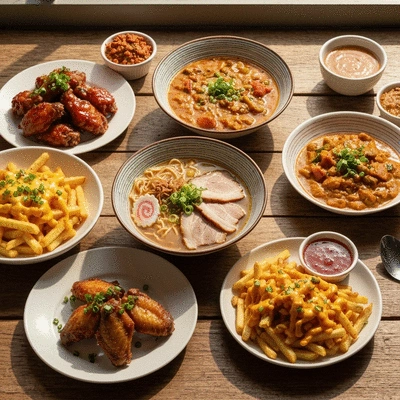
These elements are what make comfort food universal yet unique, allowing us to connect with our culture and each other over a shared love of food. At Sloppedia, we celebrate this diversity by showcasing how different dishes resonate with people around the globe!
The Emotional and Psychological Impact of Comfort Foods
Food is not just sustenance; it plays a vital role in our emotional well-being. Have you ever noticed how a bowl of soup can soothe a cold or how a slice of cake can lift your spirits? The psychological impact of comfort foods is profound. Research suggests that such foods can trigger the brain's reward system. Here’s why:
- Stress relief: Enjoying comfort foods can trigger the release of dopamine, helping to reduce stress and anxiety.
- Connection: Sharing meals fosters bonds with friends and family, enhancing our sense of belonging.
- Memory recall: The smell or taste of a favorite dish can instantly transport us back to cherished moments.
As a culinary storyteller, I love exploring these emotional connections through food. It reminds me that cooking and sharing meals can be incredibly therapeutic, a core belief at Sloppedia.
The Role of Culinary Traditions in Shaping Comfort Foods
Culinary traditions play a significant role in defining what comfort food means to different cultures. From family recipes passed down through generations to regional specialties, these traditions shape our food landscape. Academic reviews highlight how food is deeply intertwined with cultural identity and history. Here are a few ways culinary traditions influence comfort foods:
- Seasonal ingredients: Many comfort dishes are made with ingredients that are readily available during specific times of the year.
- Cultural significance: Dishes often have historical roots that reflect a culture’s story and values.
- Preparation methods: The techniques used to prepare these dishes can evoke nostalgia and a sense of home.
At Sloppedia, we delve into these narratives, allowing food lovers to appreciate and explore the rich stories behind every dish. Whether it’s a family gathering or a cultural celebration, comfort food embodies the traditions that bring us together.
Tracing the Origins of Comfort Foods Worldwide
As we continue our delicious journey, let’s trace the origins of comfort foods around the globe. Each dish has its own history, and understanding these origins helps us appreciate the flavors and traditions that accompany them!
Pro Tip
Did you know? Embracing comfort food can also be a gateway to understanding cultural diversity. When you try a dish from another culture, you're not just tasting food; you're experiencing a piece of their history and traditions. So, the next time you cook a global comfort dish, take a moment to explore its origins and the stories behind it!
Frequently Asked Questions About Comfort Foods
- 1. What is comfort food?
- Comfort food refers to dishes that evoke a sense of well-being, nostalgia, and familiarity, often due to their connection to personal memories, family, and cultural traditions. They are typically simple, easy to prepare, and made with familiar flavors.
- 2. Why do comfort foods make us feel good?
- Comfort foods have a profound psychological impact. They can trigger the release of dopamine, which helps reduce stress and anxiety. Additionally, they foster social connections when shared with loved ones and can instantly recall cherished memories through taste and smell.
- 3. How do culinary traditions influence comfort foods?
- Culinary traditions significantly shape comfort foods through the use of seasonal ingredients, historical and cultural significance, and traditional preparation methods. These elements help preserve a culture's story and values, often passed down through generations.
- 4. How do comfort foods contribute to cultural identity?
- Comfort foods are central to cultural identity by symbolizing celebrations and significant life events, fostering community bonds through shared meals, preserving family traditions via recipes, and allowing immigrant communities to adapt and create new dishes that blend traditions.
- 5. How can I explore global comfort foods in my own kitchen?
- You can incorporate global comfort foods into your cooking by researching recipes, adapting ingredients that may be hard to find, experimenting with flavors to add your unique twist, and cooking with friends to share cultural dishes. Sloppedia offers many recipes to help you get started!
Summarizing the Importance of Comfort Foods in Global Culture
At Sloppedia, we believe that comfort foods are more than just meals; they are a celebration of cultural identity and community. These dishes bring people together, transcending borders and differences. They connect us to our roots, family traditions, and cherished memories, reminding us of the cultural tapestries we are part of.
As we explore the vast world of comfort foods, it becomes clear that they play a crucial role in shaping our identities. They encapsulate the essence of who we are and where we come from, providing a delicious thread that ties us to our heritage. Embracing this diversity allows us to appreciate the rich culinary landscape that spans the globe!
Embracing Diversity: The Role of Comfort Foods in Cultural Identity
Comfort foods vary widely from one culture to another, reflecting unique ingredients, cooking methods, and traditions. Studies on food and culture emphasize how these dishes reinforce community ties. Here are some key aspects that highlight their role in cultural identity:
- Symbolism: Many comfort foods are steeped in history, often symbolizing celebrations and significant life events.
- Community: Sharing meals fosters connection and belonging, creating bonds among individuals and families.
- Tradition: Recipes passed down through generations preserve not just flavors but also stories and cultural practices.
- Adaptation: Immigrant communities often adapt traditional recipes, blending them with local ingredients to create new comfort dishes.
This rich diversity not only enriches our palates but also enhances our understanding of different cultures. Each comfort dish tells a story, inviting us to taste the world one bite at a time!
Food Stories: Sharing Personal Connections to Comfort Foods
Food has a way of igniting memories, and at Sloppedia, we cherish the personal stories that accompany comfort dishes. I often reminisce about my grandmother’s kitchen, where the aroma of her famous chicken soup would fill the air, providing warmth and solace after a long day. It's these connections that make comfort foods so special!
Here are some examples of how personal stories intertwine with comfort foods:
- Childhood Favorites: Many people have fond memories associated with dishes they grew up eating, like mac and cheese or chocolate chip cookies.
- Family Gatherings: Special occasions often revolve around favorite meals, highlighting their importance in family traditions.
- Cultural Rituals: Certain foods are prepared for specific celebrations, marking rites of passage or seasonal festivities.
- Travel Experiences: A taste of a dish enjoyed while traveling can evoke powerful memories, linking food to places visited and experiences shared.
By sharing these stories, we create a tapestry of experiences that celebrate the universal language of food. So, what’s your comfort food story? I’d love to hear it!
Encouraging Exploration of Global Comfort Foods
At Sloppedia, we’re passionate about encouraging everyone to explore the incredible world of comfort foods. There’s so much to discover and recreate in your kitchen! Whether you’re a seasoned chef or just starting out, there’s a dish waiting for you to try.

Let’s delve into how you can incorporate global comfort foods into your cooking adventures!
How to Incorporate Global Comfort Foods into Your Cooking
Bringing global comfort foods into your home cooking can be a delightful experience. Here are some tips to get you started:
- Research Recipes: Explore Sloppedia’s extensive collection of comfort food recipes from around the world and choose one that intrigues you.
- Adapt Ingredients: Don’t hesitate to substitute local ingredients for those that may be hard to find while maintaining the dish's essence.
- Experiment with Flavors: Try adding your unique twist to a traditional recipe. It could lead to a new favorite!
- Cook with Friends: Invite friends over for a cooking night, where each person brings a dish from their culture to share.
Cooking is all about exploration and creativity! The more you experiment with flavors and techniques, the more you’ll discover the joy of global comfort foods.
Exploring Recipe Variations for Popular Comfort Foods
One of the most exciting aspects of comfort foods is that they often have countless variations. Each culture puts its spin on beloved dishes, making them unique and special. Here are some popular comfort foods with notable variations:
- Pizza: From Neapolitan to Chicago deep-dish, this classic Italian dish has endless possibilities!
- Rice: Dishes like paella in Spain and biryani in India showcase how versatile rice can be.
- Stews: From the hearty Irish stew to the spicy Moroccan tagine, every culture has its take on this comforting favorite.
- Mac and Cheese: This creamy dish has variations that include everything from lobster to spicy Sriracha!
These variations not only expand our culinary horizons but also help us appreciate the cultural significance behind each dish. Which variation are you excited to try?
Join the Conversation: Share Your Favorite Comfort Foods
Here at Sloppedia, we’re all about building a community of food enthusiasts! I’d love to hear from you—what comfort foods make your heart sing? Are there recipes that remind you of home or meals that have significant stories behind them?
Feel free to share your favorite comfort dishes in the comments below or on our social media. Let’s celebrate the joy of comfort food together and inspire each other to explore further!
Recap of Key Points
Here is a quick recap of the important points discussed in the article:
- Familiarity and Nostalgia: Comfort food is defined by its ability to evoke memories and feelings of warmth.
- Emotional Connection: These foods often help reduce stress and foster connections among friends and family.
- Culinary Traditions: Recipes passed down through generations reflect cultural significance and community bonds.
- Global Exploration: Comfort foods vary widely across cultures, showcasing unique ingredients and cooking methods.
- Share Your Stories: Engaging with personal food stories enriches our understanding and appreciation of comfort foods.

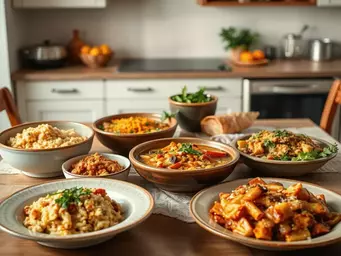
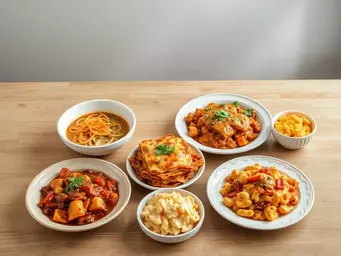

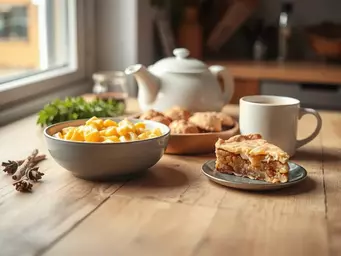
Global Comfort Foods You’ll Love
Global Comfort Foods to Savor
Exploring Comfort Food Datasets
Finding Comfort Food for You
Messy Comfort Dishes to Enjoy